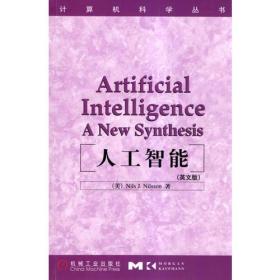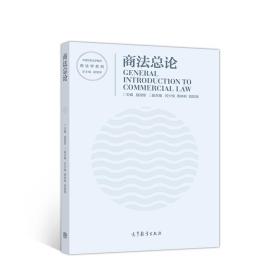
人工智能 英文版
¥ 22.09 5.8折 ¥ 38 九品
仅1件
北京昌平
认证卖家担保交易快速发货售后保障
作者[美]尼尔松 著
出版社机械工业出版社
出版时间1999-09
版次1
装帧平装
货号A5
上书时间2024-11-15
- 在售商品 暂无
- 平均发货时间 15小时
- 好评率 暂无
- 最新上架
商品详情
- 品相描述:九品
图书标准信息
- 作者 [美]尼尔松 著
- 出版社 机械工业出版社
- 出版时间 1999-09
- 版次 1
- ISBN 9787111074380
- 定价 38.00元
- 装帧 平装
- 开本 其他
- 纸张 胶版纸
- 页数 513页
- 【内容简介】
- 本书介绍了人工智能领域中最重要的一个概念——智能代理。本书从最基本的反应式代理入手,逐步向人们展示了现代人工智能不断增强的认知能力,同时也例证了该领域中重要且经久不衰的思维、思想。神经网络、遗传程序设计、计算机视觉、探视搜索、知识表示和推理、贝叶斯网络、规划和语言理解等有关人工智能的重要内容都通过本书所描述的各种代理的不断增长的能力得以展现。本书作者是人工智能领域的主要开创者和重要带头人,正是他提供给了广大读者一个耳目一新和富有生机的合成技术,该技术将领导人类把整个人工智能领域的研究引向一个新的境界。 Nils J. Nilsson: Artificial Intelligence, A New Synthesis. Copyright @ 1998 by Morgan Kaufmann Publishers, Inc. Harcourt Asia Pte Ltd under special arrangement with Morgan Kaufmann authorizes China Machine Press to print and exclusively distribute this edition, which is the only authorized complete and unabridged reproduction of the latest American Edition published and priced for sale in China only, not including Hong Kong SAR and Taiwan. Unauthorized export of this edition is a violation of the Copyright Act. Violation of this Law is subjected to Civil and Criminal penalties.
- 【目录】
-
Preface
1 Introduction
1.1 What is AI?
1.2 Approaches to Artificial Intelligence
1.3 Brief History of AI
1.4 Plan of the Book
1.5 Additional Readings and Discussion
I Reactive Machines
2 Stimulus-Response Agents
2.1 Perception and Action
2.2 Representing and Implementing Action Functions
2.3 Additional Readings and Discussion
3 Neural Networks
3.1 Introduction
3.2 Training Single TLUs
3.3 Neural Networks
3.4 Generalization, Accuracy, and Overfitting
3.5 Additional Readings and Discussion
4 Machine Evolution
4.1 Evolutionary Computation
4.2 Genetic Programming
4.3 Additional Readings and Discussion
5 State Machines
5.1 Representing the Environment by Feature Vectors
5.2 Elman Networks
5.3 Iconic Representations
5.4 Blackboard Systems
5.5 Additional Readings and Discussion
6 Robot Vision
6.1 Introduction
6.2 Steering a Van
6.3 Two Stages of Robot Vision
6.4 Image Processing
6.5 Scene Analysis
6.6 Stereo Vision
6.7 Additional Readings and Discussion
II Search in State Spaces
7 Agents that Plan
7.1 Memory Versus Computation
7.2 State-Space Graphs
7.3 Searching Explicit State Spaces
7.4 Feature-Based State Spaces
7.5 Graph Notation 7.6 Additional Readings and Discussion
8 Uninformed Search
8.1 Formulating the State Space
8.2 Components of Implicit State-Space Graphs
8.3 Breadth-First Search
8.4 Depth-First or Bracktracking Search
8.5 Iterative Deepening
8.6 Additional Readings and Discussion
9 Heuristic Search
9.1 Using Evaluation Functions
9.2 A General Graph-Searching Algorithm
9.3 Heuristic Functions and Search Efficiency
9.4 Additional Readings and Discussion
10 Planning, Acting, and Learning
10.1 The Sense/Plan/Act Cycle
10.2 Approximate Search
10.3 Learning Heuristic Functions
10.4 Rewards Instead of Goals
10.5 Additional Readings and Discussion
11 Alternative Search Formulations and Applications
11.1 Assignment Problems
11.2 Constructive Methods
11.3 Heuristic Repair
11.4 Function Optimization
12 Adversarial Search
12.1 Two-Agent Games
12.2 The Minimax Procedure
12.3 The Alpha-Beta Procedure
12.4 The Search Efficiency of the Alpha-Beta Procedure
12.5 Other Important Matters
12.6 Games of Chance
12.7 Learning Evaluation Functions
12.8 Additional Readings and Discussion
III Knowledge Representation and Reasoning
13 The Propositional Calculus
13.1 Using Constraints on Feature Values
13.2 The Language
13.3 Rules of Inference
13.4 Definition of Proof
13.5 Semantics
13.6 Soundness and Completeness
13.7 The PSAT Problem
13.8 Other Important Topics
14 Resolution in The Propositional Calculus
14.1 A New Rule of Inference: Resolution
14.2 Converting Arbitrary wffs to Conjunctions of Clauses
14.3 Resolution Refutations
14.4 Resolution Refutation Search Strategies
14.5 Horn Clauses
15 The Predicate Calculus
15.1 Motivation
15.2 The Language and its Syntax
15.3 Semantics
15.4 Quantification
15.5 Semantics of Quantifiers
15.6 Predicate Calculus as a Language for Representing Knowledge
15.7 Additional Readings and Discussion
16 Resolution in the Predicate Calculus
16.1 Unification
16.2 Predicate-Calculus Resolution
16.3 Completeness and Soundness
16.4 Converting Arbitrary wffs to Clause Form
16.5 Using Resolution to Prove Theorems
16.6 Answer Extraction
16.7 The Equality Predicate
16.8 Additional Readings and Discussion
17 Knowledge-Based Systems
17.1 Confronting the Real World
17.2 Reasoning Using Horn Clauses
17.3 Maintenance in Dynamic Knowledge Bases
17.4 Rule-Based Expert Systems
17.5 Rule Learning
17.6 Additional Readings and Discussion
18 Representing Commonsense Knowledge
18.1 The Commonsense World
18.2 Time
18.3 Knowledge Representation by Networks
18.4 Additional Readings and Discussion
19 Reasoning with Uncertain Information
19.1 Review of Probability Theory
19.2 Probabilistic Inference
19.3 Bayes Networks
19.4 Patterns of Inference in Bayes Networks
19.5 Uncertain Evidence
19.6 D-Seperation
19.7 Probabilistic Inference in Polytrees
19.8 Additional Readings and Discussion
20 Learning and Acting with Bayes Nets
20.1 Learning Bayes Nets
20.2 Probabilistic Inference and Action
20.3 Additional Readings and Discussion
IV Planning Method Based on Logic
21 The Situation Calculus
21.1 Reasoning about States and Actions
21.2 Some Difficulties
21.3 Generating Plans
21.4 Additional Reading and Discussion
22 Planning
22.1 STRIPS Planning Systems
22.2 Plan Spaces and Partial-Order Planning
22.3 Hierarchical Planning
22.4 Learning Plans'
22.5 Additional Readings and Discussion
V Communication and Integration
23 Multiple Agents
23.1 Interacting Agents
23.2 Models of Other Agents
23.3 A Modal Logic of Knowledge
23.4 Additional Readings and Discussion
24 Communication Among Agents
24.1 Speech Acts
24.2 Understanding Language Strings
24.3 Efficient Communication
24.4 Natural Language Processing
24.5 Additional Readings and Discussion
25 Agent Architectures
25.1 Three-Level Architectures
25.2 Goal Arbitration
25.3 The Triple-Tower Architecture
25.4 Bootstrapping
25.5 Additional Readings and Discussion
点击展开
点击收起
— 没有更多了 —












以下为对购买帮助不大的评价